Cougar
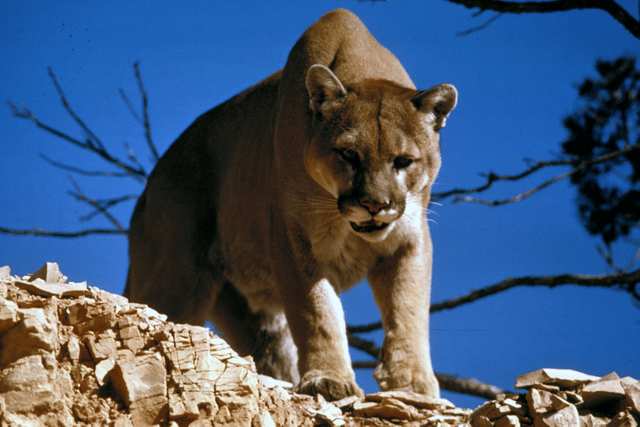
Cougar

| Cougar | |
|---|---|
| ANorth American cougarinGlacier National Park | |
| Scientific classification | |
| Kingdom: | Animalia |
| Phylum: | Chordata |
| Class: | Mammalia |
| Order: | Carnivora |
| Suborder: | Feliformia |
| Family: | Felidae |
| Subfamily: | Felinae |
| Genus: | Puma |
| Species: | |
| Binomial name | |
| Puma concolor | |
| Subspecies | |
| Cougar range | |
The cougar (Puma concolor) is a large felid of the subfamily Felinae native to the Americas.[2] Its range spans from the Canadian Yukon to the southern Andes in South America, and is the widest of any large wild terrestrial mammal in the Western Hemisphere. It is an adaptable, generalist species, occurring in most American habitat types.[4] Due to its wide range, it has many names including mountain lion, puma, red tiger, and catamount.[5]
It is the second-heaviest cat in the New World after the jaguar. Secretive and largely solitary by nature, the cougar is properly considered both nocturnal and crepuscular, although daytime sightings do occur.[6][7][8][9] The cougar is more closely related to smaller felines, including the domestic cat (subfamily Felinae), than to any species of subfamily Pantherinae,[3][10][11] of which only the jaguar is extant in the Americas.
The cougar is an ambush predator that pursues a wide variety of prey. Primary food sources are ungulates, particularly deer. It also hunts species as small as insects and rodents. This cat prefers habitats with dense underbrush and rocky areas for stalking, but can also live in open areas. The cougar is territorial and survives at low population densities. Individual territory sizes depend on terrain, vegetation, and abundance of prey. While large, it is not always the apex predator in its range, yielding prey it has killed to lone jaguars, American black bears, and grizzly bears, American alligators (Florida Panther predation mainly), and to groups of gray wolves. It is reclusive and mostly avoids people. Fatal attacks on humans are rare, but have recently been increasing in North America as more people enter cougar territories, and build developments such as farms in their established territory.[12]
Intensive hunting following European colonization of the Americas and the ongoing human development into cougar habitat has caused populations to drop in most parts of its historical range. In particular, the North American cougar is considered to have been mostly extirpated in eastern North America in the beginning of the 20th century, except for the isolated Florida panther subpopulation. Transient males have been verified in Minnesota,[13] Missouri,[14] Iowa,[15][16] Michigan, Indiana,[17] and Illinois (where a cougar was shot in the city limits of Chicago),[18][19][17] and in at least one instance, observed as far east as the Adirondack Mountains in upstate New York, and coastal Connecticut.[20] [21] [22] Reports of eastern cougars (P. c. cougar) still surface frequently in the Eastern United States, although it was declared extirpated in 2011.[23] However, it is speculated and believed by many that the Western cougar is recolonizing the Eastern cougar's former range in the Northeastern United States, and there is growing evidence that supports a small but growing population of Western cougars in the Eastern and Northeastern states, mostly cougars migrating from the Midwestern United States, though possibly also from Canada. In April 1997, an experienced tracker named John McCarter found the mauled carcass of a beaver with scat nearby in the Quabbin Reservoir in Massachusetts. The scat was tested positive as being from a mountain lion. In March 2011, Steve Ward, a DCR forester in the state of Massachusetts, photographed tracks in the Quabbin Reservoir. The tracks are believed to have been made by the same mountain lion that was seen in Minnesota, Michigan, upstate New York, and Connecticut, before later being struck by an SUV and killed in Connecticut on a highway that same year. The animal is believed to have originated from the Black Hills of South Dakota.[24] Mountain lions are well documented in the state of Wisconsin, with several confirmed sightings with photo and video evidence being as recent as August 13, 2019, with many other sightings earlier that year and during the previous year of 2018.[25]
| Cougar | |
|---|---|
| ANorth American cougarinGlacier National Park | |
| Scientific classification | |
| Kingdom: | Animalia |
| Phylum: | Chordata |
| Class: | Mammalia |
| Order: | Carnivora |
| Suborder: | Feliformia |
| Family: | Felidae |
| Subfamily: | Felinae |
| Genus: | Puma |
| Species: | |
| Binomial name | |
| Puma concolor | |
| Subspecies | |
| Cougar range | |
Naming and etymology
The word 'cougar' is borrowed from the Portuguese çuçuarana, via French; it was originally derived from the Tupi language. A current form in Brazil is suçuarana.[26] In the 17th century, Georg Marcgrave named it cuguacu ara. Marcgrave's rendering was reproduced in 1648 by his associate Willem Piso. Cuguacu ara was then adopted by John Ray in 1693.[27] In 1774, Georges-Louis Leclerc, Comte de Buffon converted cuguacu ara to cuguar, which was later modified to "cougar" in English.[28][29][30]
In the United States and Canada, it also called mountain lion.[36][37] Mountain lion was a name first used in writing in 1858.[38] Other names include panther, painter and catamount. Early Spanish explorers of the Americas called it 'gato monte' meaning cat of the mountain, and 'leon' meaning lion.[5]
Taxonomy and evolution

Felis concolor was the scientific name proposed by Carl Linnaeus in 1771 for a cat with a long tail from Brasilia.[40] It was placed in the genus Puma by William Jardine in 1834.[41] This genus is part of the Felinae.[3] The cougar is most closely related to the jaguarundi, as well as the modern cheetah of Africa and western Asia. [42][43]
Subspecies
Following Linnaeus' first scientific description of the cougar, 32 cougar zoological specimens were described and proposed as subspecies until the late 1980s. Genetic analysis of cougar mitochondrial DNA indicate that many of these are too similar to be recognized as distinct at a molecular level, but that only six phylogeographic groups exist. The Florida panther samples showed a low microsatellite variation, possibly due to inbreeding.[43] Following this research, the authors of Mammal Species of the World recognized the following six subspecies in 2005:[3]
P. c. concolor (Linnaeus, 1771) includes the synonyms bangsi, incarum, osgoodi, soasoaranna, sussuarana, soderstromii, suçuaçuara, and wavula
P. c. puma (Molina, 1782) includes the synonyms araucanus, concolor, patagonica, pearsoni, and puma (Trouessart, 1904)
P. c. couguar (Kerr, 1792) includes arundivaga, aztecus, browni, californica, floridana, hippolestes, improcera, kaibabensis, mayensis, missoulensis, olympus, oregonensis, schorgeri, stanleyana, vancouverensis, and youngi
P. c. costaricensis (Merriam, 1901)
P. c. anthonyi (Nelson and Goldman, 1931) includes acrocodia, borbensis, capricornensis, concolor, greeni, and nigra
Puma c. cabrerae Pocock, 1940 includes hudsonii and puma proposed by Marcelli in 1922
In 2006, the Florida panther was still referred to as a distinct subspecies P. c. coryi in research works.[44]
As of 2017, the Cat Classification Taskforce of the Cat Specialist Group recognizes only two subspecies as valid:[45]
P. c. concolor
P. c. couguar
Evolution
The family Felidae is believed to have originated in Asia about 11 million years ago. Taxonomic research on felids remains partial, and much of what is known about their evolutionary history is based on mitochondrial DNA analysis.[42] Significant confidence intervals exist with suggested dates. In the latest genomic study of the Felidae, the common ancestor of today's Leopardus, Lynx, Puma, Prionailurus, and Felis lineages migrated across the Bering land bridge into the Americas 8.0 to 8.5 million years ago (Mya). The lineages subsequently diverged in that order.[42] North American felids then invaded South America 2–4 Mya as part of the Great American Interchange, following formation of the Isthmus of Panama.[43] but the relationship is unresolved. The cheetah lineage is suggested by some studies to have diverged from the Puma lineage in the Americas (see American cheetah) and migrated back to Asia and Africa,[42][43] while other research suggests the cheetah diverged in the Old World itself.[46] A high level of genetic similarity has been found among North American cougar populations, suggesting they are all fairly recent descendants of a small ancestral group.
Culver et al. propose the original North American population of P. concolor was extirpated during the Pleistocene extinctions some 10,000 years ago, when other large mammals, such as Smilodon, also disappeared. North America was then repopulated by a group of South American cougars.[43]
The jaguarundi, which is known as the cougar's closest relative, was formerly placed within the same genus, Puma. It is now most often placed in the genus Herpailurus.[45]
A coprolite identified as from a cougar was excavated in Argentina's Catamarca Province and dated to 17002–16573 years old. It contained Toxascaris leonina eggs. This finding indicates that cougar and the parasite existed in South America since at least the Late Pleistocene.[47]
Characteristics
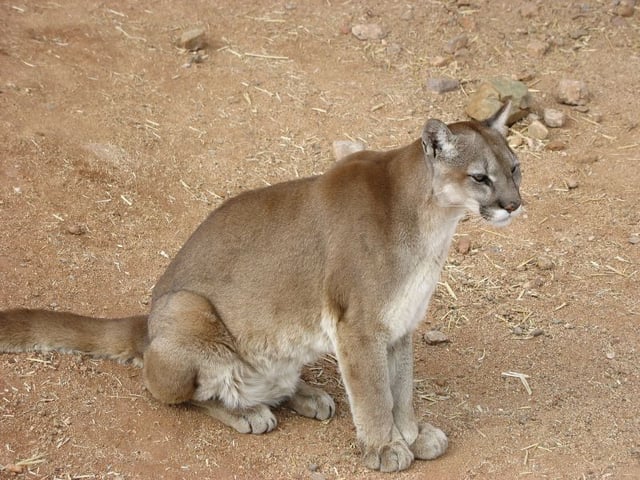
Although cougars somewhat resemble the domestic cat, they are about the same size as an adult human
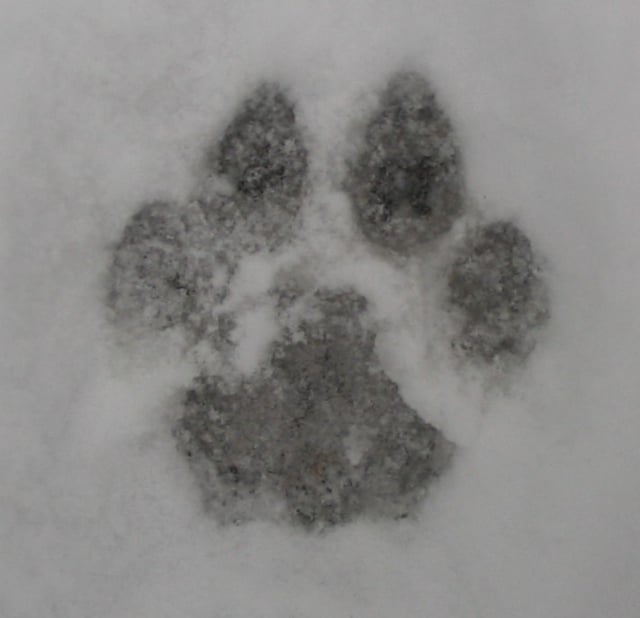
Front paw print of a cougar.
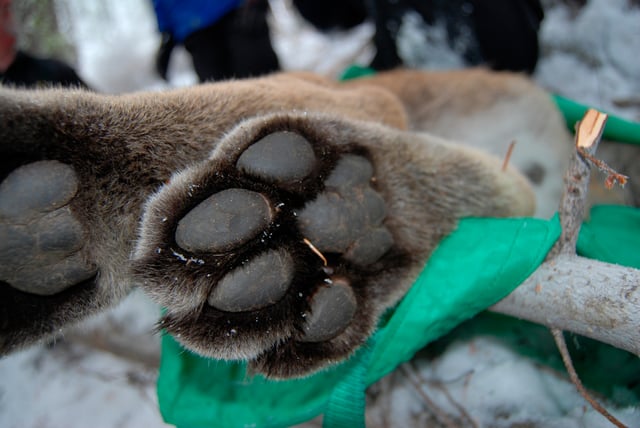
Rear paw of a cougar

Cougar skull and jawbone
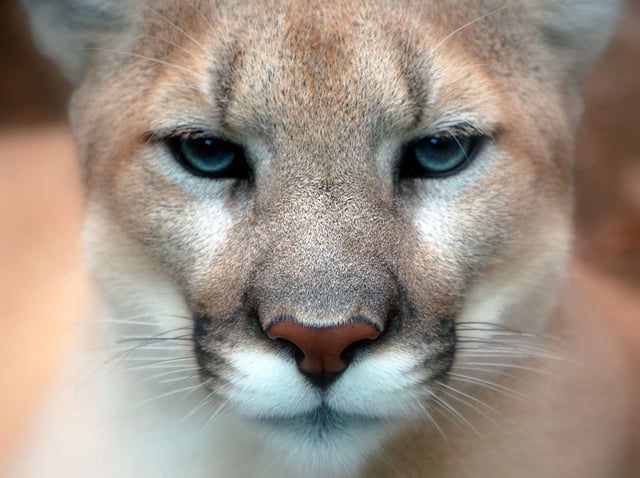
Adult cougars have blue eyes
The head of the cat is round and the ears are erect.
Its powerful forequarters, neck, and jaw serve to grasp and hold large prey.
It has five retractable claws on its forepaws (one a dewclaw) and four on its hind paws. The larger front feet and claws are adaptations to clutching prey.[49]
Cougars are slender and agile members of the Felidae. They are the fourth-largest cat species worldwide;[50] adults stand about 60 to 90 cm (24 to 35 in) tall at the shoulders.[51] Adult males are around 2.4 m (7.9 ft) long from nose to tail tip, and females average 2.05 m (6.7 ft), with overall ranges between 1.50 to 2.75 m (4.9 to 9.0 ft) nose to tail suggested for the species in general.[52][53] Of this length, the tail typically accounts for 63 to 95 cm (25 to 37 in).[54] Males generally weigh 53 to 100 kg (117 to 220 lb), averaging 68 kg (150 lb). Females typically weigh between 29 and 64 kg (64 and 141 lb), averaging 55 kg (121 lb).[55][54][56][57] Cougar size is smallest close to the equator and larger towards the poles.[4] The largest recorded cougar, shot in 1901, weighed 105.2 kg (232 lb); claims of 125.2 kg (276 lb) and 118 kg (260 lb) have been reported, though they were most likely exaggerated.[58] On average, adult male cougars in British Columbia weigh 56.7 kg (125 lb) and adult females 45.4 kg (100 lb), though several male cougars in British Columbia weighed between 86.4 and 95.5 kg (190 and 211 lb).[59]
Depending on the locality, cougars can be smaller or bigger than jaguars, but are less muscular and not as powerfully built so their weight is on average less.
Whereas cougars tend to be larger as distance increases from the equator,[4] which crosses the northern portion of South America, jaguars are simply generally smaller north of the Amazon River in South America and larger south of that river.
For example, while South American jaguars are comparatively large and may exceed 90 kg (200 lb),[60] those in Mexico's Chamela-Cuixmala Biosphere Reserve weigh about the same as female cougars (approximately 50 kg (110 lb)).[61]
The cougar is on average larger than all felid species apart from the lion, tiger, and jaguar. Despite its size, it is not typically classified among the "big cats" because it cannot roar, lacking the specialized larynx and hyoid apparatus of Panthera.[62] Compared to "big cats", cougars are often silent with minimal communication through vocalizations outside of the mother-offspring relationship.[63] Cougars sometimes voice low-pitched hisses, growls, and purrs, as well as chirps and whistles, many of which are comparable to those of domestic cats. They are well known for their screams, as referenced in some of their common names, although these screams are often misinterpreted to be the calls of other animals or humans.[64]
Cougar coloring is plain (hence the Latin concolor) but can vary greatly across individuals and even siblings. The coat is typically tawny like that of the lion, which is why it was initially called the "mountain lion",[56] but it otherwise ranges from silvery-grey or reddish with lighter patches on the underbody, including the jaws, chin, and throat. Infants are spotted and born with blue eyes and rings on their tails;[56] juveniles are pale and dark spots remain on their flanks.[53] Despite anecdotes to the contrary, all-black coloring (melanism) has never been documented in cougars.[65] The term "black panther" is used colloquially to refer to melanistic individuals of other species, particularly jaguars and leopards.[66]
Cougars have large paws and proportionally the largest hind legs in Felidae,[56] allowing for their great leaping and short-sprint ability.
The cougar's top running speed ranges between 64 and 80 km/h (40 and 50 mph),[67][68] but is best adapted for sprints rather than long chases. It is adept at climbing, which allows it to evade canine competitors. Although it is not strongly associated with water, it can swim.[69]
Distribution and habitat
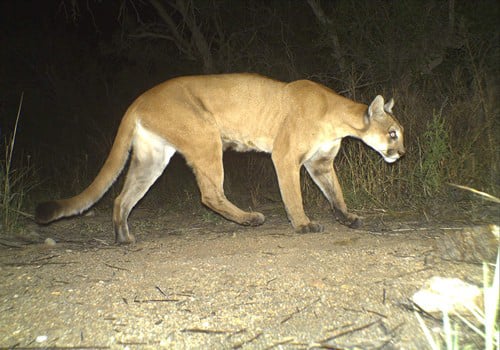
A camera trap image of a cougar in Saguaro National Park, Arizona
The cougar has the largest range of any wild land animal in the Americas.
Its range spans 110 degrees of latitude, from northern Yukon in Canada to the southern Andes. Its wide distribution stems from its adaptability to virtually every habitat type; it is found in all forest types, as well as in lowland and mountainous deserts. The cougar prefers habitats that include precipitous canyons, escarpments, rim rocks, and dense brush,[69] but can also live in open areas with little vegetation.[2]
The cougar was extirpated across nearly all of its eastern North American range (with the exception of Florida) in the two centuries after European colonization, and faced grave threats elsewhere. It currently ranges across most western American states, the Canadian provinces of Alberta, Saskatchewan and British Columbia, and the Canadian territory of Yukon. There have been widely debated reports of possible recolonization of eastern North America.[70] DNA evidence has suggested its presence in eastern North America,[71] while a consolidated map of cougar sightings shows numerous reports from the mid-western Great Plains through to eastern Canada.[72] The Quebec wildlife services also considers cougar to be present in the province as a threatened species after multiple DNA tests confirmed cougar hair in lynx mating sites.[73] The only unequivocally known eastern population is the critically endangered Florida panther. There have been unconfirmed sightings in Elliotsville Plantation, Maine (north of Monson) and as early as 1997 in New Hampshire.[74] In 2009, the Michigan Department of Natural Resources confirmed a cougar sighting in Michigan's Upper Peninsula.[75] Typically, extreme-range sightings of cougars involve young males, which can travel great distances to establish ranges away from established males. All four confirmed cougar kills in Iowa since 2000 involved males.[76]
On April 14, 2008, police fatally shot a cougar on the north side of Chicago, Illinois. DNA tests were consistent with cougars from the Black Hills of South Dakota. Less than a year later, on March 5, 2009, a cougar was photographed and unsuccessfully tranquilized by state wildlife biologists in a tree near Spooner, Wisconsin, in the northwestern part of the state.[77] Other eastern sightings since 2010 have occurred in locations such as Greene County, Indiana,[78] Greenwich[79] and Milford, Connecticut,[80] Morgan County[81] Pike County,[82] and Whiteside County, Illinois,[83] and Bourbon County, Kentucky.[84]
In Tennessee, no confirmed sightings had been made since the early 1900s. The first confirmed sighting in a century was made on September 20, 2015, in Obion county in the north-western corner of West Tennessee. Six days later, and about 35 miles to the southeast, a hair sample was found in Carroll County. DNA analysis revealed that it was from a female genetically similar to South Dakota cougars. Since then there have been at least eight additional confirmed sightings in the state; all were immediately east of the Tennessee River in Middle Tennessee: initially in Humphreys county and on September 4, 2016, further south in Wayne county.[85]
The cougar's total breeding population is estimated at less than 50,000 by the IUCN, with a declining trend.[2] US state-level statistics are often more optimistic, suggesting cougar populations have rebounded.
In Oregon, a healthy population of 5,000 was reported in 2006, exceeding a target of 3,000.[87] California has actively sought to protect the cat and has an estimated population of 4,000 to 6,000.[88]
A 2012 study using 18 motion-sensitive cameras in Río Los Cipreses National Reserve counted a population of two males and two females, one of them with at least two cubs, in an area of 600 km2 (0.63 cougars per 100 km2).[89] The Bay Area Puma Project aims to obtain information on cougar populations in the San Francisco Bay area and the animals' interactions with habitat, prey, humans, and residential communities.[90]
Habitat fragmentation
With the increase of human development and infrastructure growth in California, the North American Cougar populations are becoming more isolated from one another.[91]
Behavior and ecology
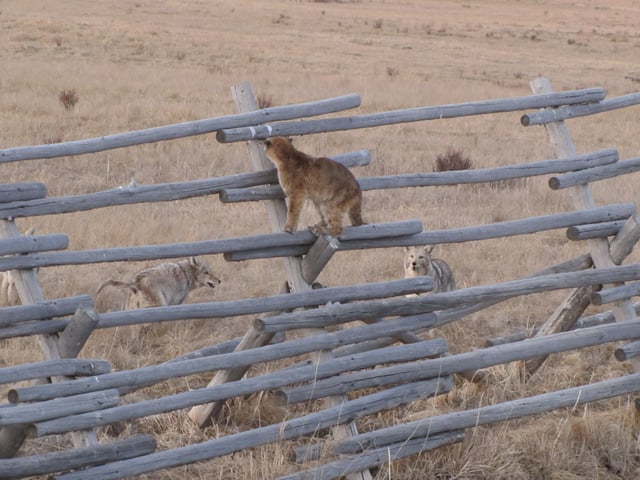
Juvenile cougars in conflict with coyotes at National Elk Refuge
Aside from humans, no species preys upon mature cougars in the wild, although conflicts with other predators or scavengers occur.
Of the large predators in Yellowstone National Park – the grizzly bear, the black bear, the gray wolf, and the cougar – the massive grizzly bear appears dominant, often (but not always) able to drive a gray wolf pack, a black bear, and a cougar off their kills. One study found that grizzlies and American black bears visited 24% of cougar kills in Yellowstone and Glacier National Parks, usurping 10% of carcasses. Bears gained up to 113% and cougars lost up to 26% of their respective daily energy requirements from these encounters.[92] In Colorado and California, black bears were found to visit 48% and 77% of kills, respectively. In general, cougars are subordinate to black bears when it comes to kills and when bears are most active, the cats take prey more frequently and spend less time feeding on each kill. Unlike several subordinate predators from other ecosystems, cougars do not appear to take advantage of spatial or temporal refuges to avoid their competitors.[93][94]
The gray wolf and the cougar compete more directly for prey, mostly in winter.
Packs of wolves can steal cougars' kills and occasionally kill the cat.
One report describes a large pack of 7 to 11 wolves killing a female cougar and her kittens.[95] Conversely, lone female wolves have in various documented accounts been ambushed and killed by cougars,[96][97][98] including in one involving a six-year-old female wolf.[99] Wolves more broadly affect cougar population dynamics and distribution by dominating territory and prey opportunities, and disrupting the feline's behavior. Preliminary research in Yellowstone, for instance, has shown displacement of the cougar by wolves.[100] In nearby Sun Valley, Idaho, a cougar/wolf encounter that resulted in the death of the cougar was documented.[101] One researcher in Oregon noted: "When there is a pack around, cougars are not comfortable around their kills or raising kittens [...] A lot of times a big cougar will kill a wolf, but the pack phenomenon changes the table."[102]
In the southern portion of its range, the cougar and jaguar share overlapping territory.[105] The jaguar tends to take the larger prey where ranges overlap, reducing both the cougar's potential size and the likelihood of direct competition between the two cats.[4] Cougars appear better than jaguars at exploiting a broader prey niche and smaller prey.[61]
As with any predator at or near the top of its food chain, the cougar impacts the population of prey species. Predation by cougars has been linked to changes in the species mix of deer in a region. For example, a study in British Columbia observed that the population of mule deer, a favored cougar prey, was declining while the population of the less frequently preyed-upon white-tailed deer was increasing.[107] The Vancouver Island marmot, an endangered species endemic to one region of dense cougar population, has seen decreased numbers due to cougar and gray wolf predation.[108] Nevertheless, there is a measurable effect on the quality of deer populations by puma predation.[109][110]
Hunting and diet
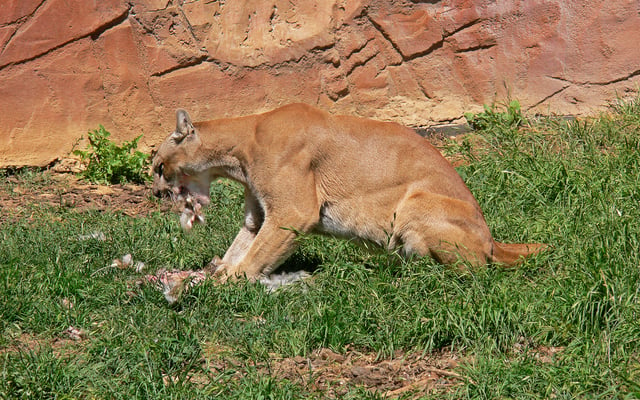
A captive cougar feeding. Cougars are ambush predators, feeding mostly on deer and other mammals.
A successful generalist predator, the cougar will eat any animal it can catch, from insects to large ungulates (over 500 kg (1,100 lb)). Like other cats, it is an obligate carnivore, meaning it must feed on meat to survive. The mean weight of vertebrate prey (MWVP) that pumas attack increases with the puma's body weight; in general, MWVP is lower in areas closer to the equator.[4] Its most important prey species are various deer species, particularly in North America; mule deer, white-tailed deer, elk, and even bull moose are taken. Other species such as the bighorn and Dall's sheep, horse, fallow deer, caribou, mountain goat, coyote and pronghorn.[113] A survey of North America research found 68% of prey items were ungulates, especially deer. Only the Florida panther showed variation, often preferring feral hogs and armadillos.[4]
Investigations at Yellowstone National Park showed that elk, followed by mule deer, were the cougar's primary targets; the prey base is shared with the park's gray wolves, with which the cougar competes for resources.[103] Another study on winter kills (November–April) in Alberta showed that ungulates accounted for greater than 99% of the cougar diet. Learned, individual prey recognition was observed, as some cougars rarely killed bighorn sheep, while others relied heavily on the species.[114]
In the Central and South American cougar range, the ratio of deer in the diet declines.
Small to mid-sized mammals are preferred, including large rodents such as the capybara. Ungulates accounted for only 35% of prey items in one survey, about half that of North America. Competition with the larger jaguar in South America has been suggested for the decline in the size of prey items.[4] However, a study by Gutiérrez-González and López-González showed that the cougar and jaguar in Central or North America may share the same prey, depending on its abundance.[116] Other listed prey species of the cougar include mice, porcupines, beavers, raccoons, hares, guanaco, peccary, vicuna, rhea, and wild turkey.[117] Birds and small reptiles are sometimes preyed upon in the south, but this is rarely recorded in North America.[4]
Although capable of sprinting, the cougar is typically an ambush predator. It stalks through brush and trees, across ledges, or other covered spots, before delivering a powerful leap onto the back of its prey and a suffocating neck bite. The cougar is capable of breaking the neck of some of its smaller prey with a strong bite and momentum bearing the animal to the ground.[49]
Kills are generally estimated around one large ungulate every two weeks.
The period shrinks for females raising young, and may be as short as one kill every three days when cubs are nearly mature around 15 months.[56] The cat drags a kill to a preferred spot, covers it with brush, and returns to feed over a period of days.
The cougar is generally reported to not be a scavenger, but deer carcasses left exposed for study were scavenged by cougars in California, suggesting more opportunistic behavior.[118]
Reproduction and life cycle
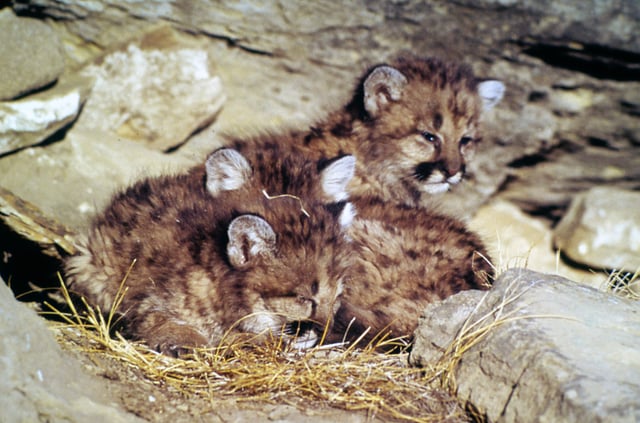
Cubs
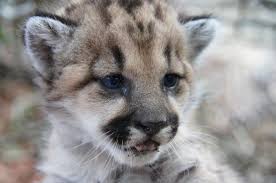
North American cougar cub at Malibu Springs
Females reach sexual maturity between one-and-a-half to three years of age.
They typically average one litter every two to three years throughout their reproductive lives,[119] though the period can be as short as one year.[56] Females are in estrus for about 8 days of a 23-day cycle; the gestation period is approximately 91 days.[56] Females are sometimes reported as monogamous,[120] but this is uncertain and polygyny may be more common.[121] Copulation is brief but frequent. Chronic stress can result in low reproductive rates when in captivity as well as in the field.[122]
Only females are involved in parenting.
Litter size is between one and six cubs; typically two.
Caves and other alcoves that offer protection are used as litter dens.
Born blind, cubs are completely dependent on their mother at first, and begin to be weaned at around three months of age.
As they grow, they begin to go out on forays with their mother, first visiting kill sites, and after six months beginning to hunt small prey on their own.[119] Kitten survival rates are just over one per litter.[56] Newborn cougars have spots that fade and eventually disappear by the age of 2 1/2 years.[123] Juveniles remain with their mothers at least for two years.[124]
Young adults leave their mother to attempt to establish their own territories at around two years of age and sometimes earlier; males tend to leave sooner.
One study has shown high mortality amongst cougars that travel farthest from the maternal range, often due to conflicts with other cougars (intraspecific competition).[119] Research in New Mexico has shown that "males dispersed significantly farther than females, were more likely to traverse large expanses of non-cougar habitat, and were probably most responsible for nuclear gene flow between habitat patches."[125]
Life expectancy in the wild is reported at eight to 13 years, and probably averages eight to 10; a female of at least 18 years was reported killed by hunters on Vancouver Island.[56] Cougars may live as long as 20 years in captivity. A male North American cougar (P. c. couguar) named "Scratch" was two months short of his 30th birthday when he died in 2007.[126] Causes of death in the wild include disability and disease, competition with other cougars, starvation, accidents, and, where allowed, human hunting. Feline immunodeficiency virus, an endemic HIV-like virus in cats, is well-adapted to the cougar.[127]
Social structure and home range
Like almost all cats, the cougar is a mostly solitary animal.
Only mothers and kittens live in groups, with adults meeting rarely.
While generally loners, cougars will reciprocally share kills with one another and seem to organize themselves into small communities defined by the territories of dominant males.
Cats within these areas socialize more frequently with each other than with outsiders.[128] Estimates of territory sizes for cougars vary greatly.
Canadian Geographic reports large male territories of 150 to 1000 km2 (58 to 386 sq mi) with female ranges half that size.[120] Other research suggests a much smaller lower limit of 25 km2 (10 sq mi), but an even greater upper limit of 1300 km2 (500 sq mi) for males.[119] In the United States, very large ranges have been reported in Texas and the Black Hills of the northern Great Plains, in excess of 775 km2 (300 sq mi).[129] Male ranges may include or overlap with those of females but, at least where studied, not with those of other males, which reduces conflict between cougars. Ranges of females may overlap slightly with each other. Scrape marks, urine, and feces are used to mark territory and attract mates. Males may scrape together a small pile of leaves and grasses and then urinate on it as a way of marking territory.[69]
Home range sizes and overall cougar abundance depend on terrain, vegetation, and prey abundance.[119] One female adjacent to the San Andres Mountains was found with a large range of 215 km2 (83 sq mi), necessitated by poor prey abundance.[125] Research has shown cougar abundances from 0.5 animals to as much as 7 (in one study in South America) per 100 km2 (38 sq mi).[56]
Because males disperse farther than females and compete more directly for mates and territory, they are more likely to be involved in conflict.
Where a juvenile fails to leave his maternal range, for example, he may be killed by his father.[129] When males encounter each other, they hiss, spit, and may engage in violent conflict if neither backs down.[121] Hunting or relocation of the cougar may increase aggressive encounters by disrupting territories and bringing young, transient animals into conflict with established individuals.[130]
Threats
The cougar is threatened by habitat loss, habitat fragmentation, and depletion of its prey base due to poaching. In Florida, it is threatened by heavy traffic, which causes frequent fatal accidents involving cougars. Highways are a major barrier for dispersal of cougars.[2]
Conservation status
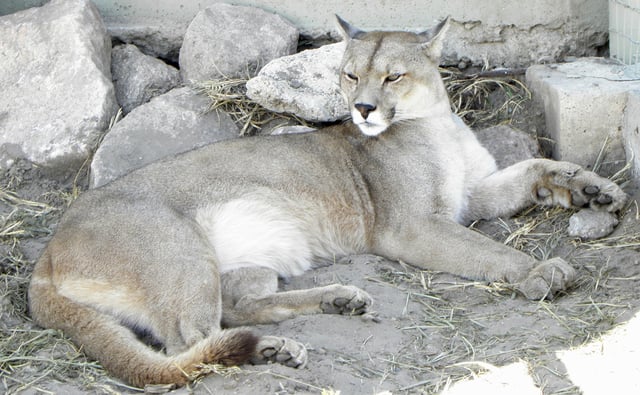
Captive cougar in a zoological park
The cougar is listed as least concern on the IUCN Red List since 2008. It is also listed on CITES Appendix II.[2] Hunting it is prohibited in California, Costa Rica, Honduras, Nicaragua, Guatemala, Panama, Venezuela, Colombia, French Guiana, Suriname, Bolivia, Brazil, Chile, Paraguay, Uruguay and most of Argentina.[56] Establishing wildlife corridors and protecting sufficient range areas are critical for the sustainability of cougar populations. Research simulations showed that it faces a low extinction risk in areas, which are larger than 2,200 km2 (850 sq mi). Between one and four new individuals entering a population per decade markedly increases persistence, thus highlighting the importance of habitat corridors.[131]
In the United States east of the Mississippi River, the only unequivocally known cougar population is the Florida panther. Until 2011, the United States Fish and Wildlife Service (USFWS) recognized both an Eastern cougar (claimed to be a subspecies by some, denied by others)[132][133] and the Florida panther, affording protection under the Endangered Species Act.[134][135] In 2003, the documented count for the Florida sub-population was 87 individuals.[136] In March 2011, the USFWS declared the Eastern cougar extinct. With the taxonomic uncertainty about its existence as a subspecies as well as the possibility of eastward migration of cougars from the western range, the subject remains open.[137][138]
This uncertainty has been recognized by Canadian authorities.
The Canadian federal agency called Committee on the Status of Endangered Wildlife in Canada rates its current data as "insufficient" to draw conclusions regarding the eastern cougar's survival and its website says that "despite many sightings in the past two decades from eastern Canada, there are insufficient data to evaluate the taxonomy or assign a status to this cougar." Notwithstanding numerous reported sightings in Ontario, Quebec, New Brunswick and Nova Scotia, it has been said that the evidence is inconclusive as "there may not be a distinct 'eastern' subspecies, and some sightings may be of escaped pets."[139][140][141]
Regulated cougar hunting is still common in the United States and Canada.
Although cougars are protected from all hunting in the Yukon; hunting is permitted in every U.S. state except California from the Rocky Mountains to the Pacific Ocean. The cougar cannot be legally killed without a permit in California except under very specific circumstances, such as when a cougar is in act of pursuing livestock or domestic animals, or is declared a threat to public safety.[88]
Texas is the only U.S. state with a viable cougar population that is not protected.
In Texas, the cougar is considered as nuisance wildlife and any person holding a hunting or a trapping permit can kill a cougar regardless of the season, number killed, sex or age of the animal.[142] The non-profit organization Balanced Ecology Inc. launched the Texas Mountain Lion Conservation Project in 2009.
The project aims at raising awareness of local people about the status and ecological role of the cougar, and mitigating conflict between landowners and cougars.[143] Cougars are generally hunted with packs of dogs until the animal is "treed," after which the hunter shoots the cat from the tree at close range.
Relationships with humans
Attacks on humans
In North America
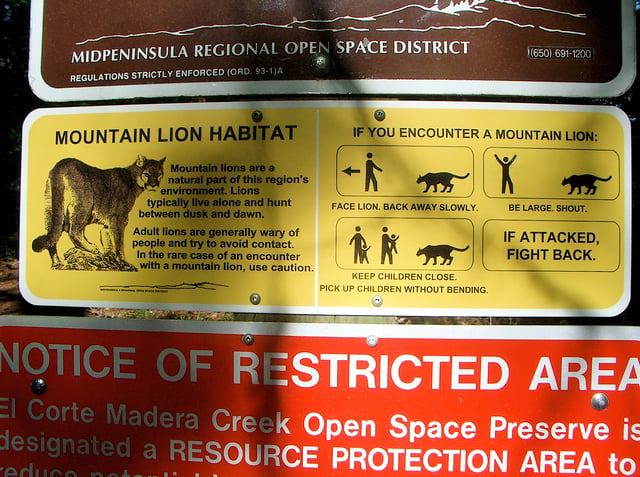
Mountain Lion warning sign in California, US.
The pertinent North American subspecies is P. concolor couguar.
Due to the expanding human population, cougar ranges increasingly overlap with areas inhabited by humans. Attacks on humans are very rare, as cougar prey recognition is a learned behavior and they do not generally recognize humans as prey.[12] In a 10-year study in New Mexico of wild cougars who were not habituated to humans, the animals did not exhibit threatening behavior to researchers who approached closely (median distance=18.5 m; 61 feet) except in 6% of cases; 14/16 of those were females with cubs.[144] Attacks on people, livestock, and pets may occur when a puma habituates to humans or is in a condition of severe starvation. Attacks are most frequent during late spring and summer, when juvenile cougars leave their mothers and search for new territory.[48]
Within North America, the distribution of attacks is not uniform.
The heavily populated state of California saw a dozen attacks 1986 to 2004 (after just three from 1890 to 1985), including three fatalities.[88] Washington state was the site of a fatal attack in 2018, its first since 1924.[147] Lightly populated New Mexico reported an attack in 2008, the first there since 1974.[148]
As with many predators, a cougar may attack if cornered, if a fleeing human stimulates their instinct to chase, or if a person "plays dead". Standing still may cause the cougar to consider a person easy prey.[149] Exaggerating the threat to the animal through intense eye contact, loud shouting, and any other action to appear larger and more menacing, may make the animal retreat. Fighting back with sticks and rocks, or even bare hands, is often effective in persuading an attacking cougar to disengage.[12][48]
When cougars do attack, they usually employ their characteristic neck bite, attempting to position their teeth between the vertebrae and into the spinal cord. Neck, head, and spinal injuries are common and sometimes fatal.[12] Children are at greatest risk of attack, and least likely to survive an encounter. Detailed research into attacks prior to 1991 showed that 64% of all victims – and almost all fatalities – were children. The same study showed the highest proportion of attacks to have occurred in British Columbia, particularly on Vancouver Island where cougar populations are especially dense.[145] Preceding attacks on humans, cougars display aberrant behavior, such as activity during daylight hours, a lack of fear of humans, and stalking humans. There have sometimes been incidents of pet cougars mauling people.[150][151]
Research on new wildlife collars may be able to reduce human-animal conflicts by predicting when and where predatory animals hunt.
This may save the lives of humans, pets, and livestock as well as the lives of these large predatory mammals that are important to the balance of ecosystems.[152]
In South America
Pumas in the Southern cone of America – often called Argentine cougars by North Americans – are reputed to be extremely reluctant to attack man; in legend, they defended people against jaguars.[153] The nineteenth century naturalists Félix de Azara[154] and William Henry Hudson[155] thought that attacks on people, even children or sleeping adults, did not happen. Hudson, citing anecdotal evidence from hunters, claimed that pumas were positively inhibited from attacking people, even in self-defense. In fact, attacks on humans, although exceedingly rare, have occurred.[156][157]
An early, authenticated, non-fatal case occurred near Lake Viedma, Patagonia in 1877 when a female mauled the Argentine scientist Francisco P. Moreno; Moreno afterwards showed the scars to Theodore Roosevelt. In this instance, however, Moreno had been wearing a guanaco-hide poncho round his neck and head as protection against the cold;[156] in Patagonia the guanaco is the puma's chief prey animal.[159] Another authenticated case occurred In 1997 in Iguazú National Park, northeast Argentina when the 20-month son of a ranger was killed by a female puma. Forensic analysis found specimens of the child's hair and clothing fibers in the animal's stomach. In this area the coatí is the puma's chief prey. Despite prohibitory signs, coatis are hand-fed by tourists in the park, causing unnatural approximation between cougars and humans. This particular puma had been raised in captivity and released into the wild.[160] In 2012 a 23-year-old woman was found dead in a mountainous area in Salta Province in northwest Argentina. Claw incisions, which severed a jugular vein, indicated that the attacker was a felid; differential diagnosis ruled out other possible perpetrators.[1] There were no bite marks on the victim, who had been herding goats.[161]
Fatal attacks by other carnivores such as feral dogs can be misattributed to pumas without appropriate forensic knowledge.[162]
Livestock predation

A 1920s silent film created by the United States Department of Agriculture which explains the procedures to successfully hunt livestock-threatening cougars
During the early years of ranching, cougars were considered on par with wolves in destructiveness.
According to figures in Texas in 1990, 86 calves (0.0006% of Texas's 13.4 million cattle and calves), 253 mohair goats, 302 mohair kids, 445 sheep (0.02% of Texas's 2 million sheep and lambs) and 562 lambs (0.04% of Texas's 1.2 million lambs) were confirmed to have been killed by cougars that year.[163][164] In Nevada in 1992, cougars were confirmed to have killed nine calves, one horse, four foals, five goats, 318 sheep, and 400 lambs. In both reports, sheep were the most frequently attacked. Some instances of surplus killing have resulted in the deaths of 20 sheep in one attack.[165] A cougar's killing bite is applied to the back of the neck, head, or throat and the cat inflicts puncture marks with its claws usually seen on the sides and underside of the prey, sometimes also shredding the prey as it holds on. Coyotes also typically bite the throat but the work of a cougar is generally clean, while bites inflicted by coyotes and dogs leave ragged edges. The size of the tooth puncture marks also helps distinguish kills made by cougars from those made by smaller predators.[166]
Remedial hunting appears to have the paradoxical effect of increased livestock predation and complaints of human-puma conflicts.
In a 2013 study the most important predictor of puma problems were remedial hunting of puma the previous year.
Each additional puma on the landscape increased predation and human-puma complaints by 5%, but each additional animal killed on the landscape during the previous year increased complaints by 50%.
The effect had a dose-response relationship with very heavy (100% removal of adult puma) remedial hunting leading to a 150% – 340% increase in livestock and human conflicts.[167] This effect is attributed to the removal of older pumas that have learned to avoid people and their replacement by younger males that react differently to humans.
Remedial hunting enables younger males to enter the former territories of the older animals.[168][169]
In mythology
The grace and power of the cougar have been widely admired in the cultures of the indigenous peoples of the Americas. The Inca city of Cusco is reported to have been designed in the shape of a cougar, and the animal also gave its name to both Inca regions and people. The Moche people represented the puma often in their ceramics.[170] The sky and thunder god of the Inca, Viracocha, has been associated with the animal.[171]
In North America, mythological descriptions of the cougar have appeared in the stories of the Hocąk language ("Ho-Chunk" or "Winnebago") of Wisconsin and Illinois[172] and the Cheyenne, amongst others. To the Apache and Walapai of Arizona, the wail of the cougar was a harbinger of death.[173] The Algonquins and Ojibwe believe that the cougar lived in the underworld and was wicked, whereas it was a sacred animal among the Cherokee.[174]
In sports
Several sports teams currently or in the past have used the cougar as the mascot /nickname for their team, although the name actually used has depended on the most popular regional name for the species.
In college sports teams, Brigham Young University in Utah and Washington State University in the northwestern United States and the University of Houston on the Great Plains of the United States use the cougar as their mascot. On Canada's prairies, Mount Royal University in Calgary and the University of Regina in Saskatchewan use the cougar as their mascot.
In professional hockey, the cougar was used by two mid-western teams and one northwestern team.
The Chicago Cougars of the World Hockey Association operated from 1972–1975 while the now-Detroit Red Wings of the National Hockey League were called the Cougars from their inaugural season in 1926 until 1930. The Detroit Cougars were actually related to the Victoria Cougars of the Western Hockey League, which had won the Stanley Cup in 1925, in that when the Victoria Cougars, which had operated as the Aristocrats from 1918 to 1922 and as the Cougars from 1922–1926, disbanded in 1926, the owners of the newly formed Detroit club purchased the rights to many of the players of the Victoria club and retained the Cougar nickname. The University of Vermont also uses the mascot, but uses the term "catamount" instead of cougar, as was traditional in the region where the school is located. The Florida Panthers of the National Hockey League use the name/image of the southeastern United States cougar subspecies, the Florida panther (the state animal), as its mascot.
The University of Pittsburgh in western Pennsylvania also uses the cougar as its sports mascot and for many other clubs and organizations, but also uses the locally preferred name, "panther", corresponding to nearby geographic features Panther Hollow and Panther Hollow Lake which were named that by 1885, 24 years before the University selected the name for its teams.[175] The University of Pittsburgh campus has about 20 physical representations of panthers/cougars at different locations around the campus plus there are four such statues on the Panther Hollow Bridge over Panther Hollow. By contrast, Penn State University in central Pennsylvania uses the Nittany Lion as its mascot, "Nittany" being the name of a nearby mountain and of the valley in which the University is located, and "lion" being the abbreviated name of a stuffed mountain lion/cougar originally captioned as "Brush Lion" that was on display in a building at the University, and which is today housed in the Penn State All-Sports Museum.[176] The campus also has a Nittany Lion Shrine featuring a large statue of a mountain lion on campus. Many high schools also use the cougar as their sports team mascot.
The Sacramento Mountain Lions (2010–2012) of the United Football League used the California and southwestern United States regional name of the species.
The Carolina Panthers of the National Football League have a black cat on their uniforms as opposed to a brownish- or tawny-coloured cat so it is most often presumed to represent a black panther, the black melanistic phase of either the jaguar, which actually only lived in the far southwestern United States not the southeastern United States where Carolina is located, or the leopard of Africa and Asia. A previously existing "Carolina" sports team, the Carolina Cougars, who operated in the American Basketball Association from 1969 to 1974, actually used the cougar as its nickname/mascot, as opposed to the panther.
Most sports team named the "Wildcats" use a logo similar to a bobcat, or in some cases in Canada, a lynx, names which are often used for sports teams in their own right.
By contrast, Wildcat Lager Beer brewed by Labatt, has always shown a picture of a cougar on its label.
Hybrids
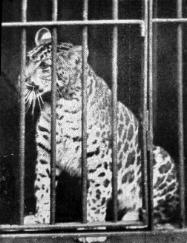
Pumapard, photographed in 1904
A pumapard is a hybrid animal resulting from a union between a puma and a leopard. Whether born to a female puma mated to a male leopard or to a male puma mated to a female leopard, pumapards inherit a form of dwarfism. Those reported grew to only half the size of the parents. They have a puma-like long body (proportional to the limbs, but nevertheless shorter than either parent), but short legs. The coat is variously described as sandy, tawny or greyish with brown, chestnut or "faded" rosettes.[177]
See also
Acinonychini